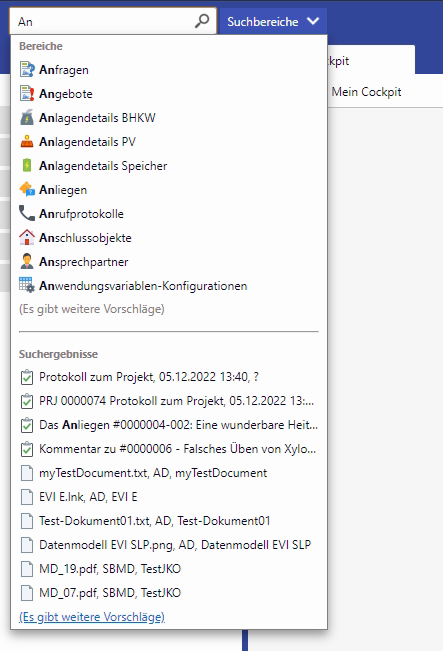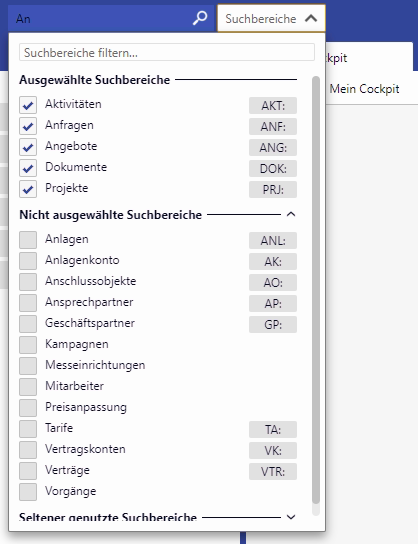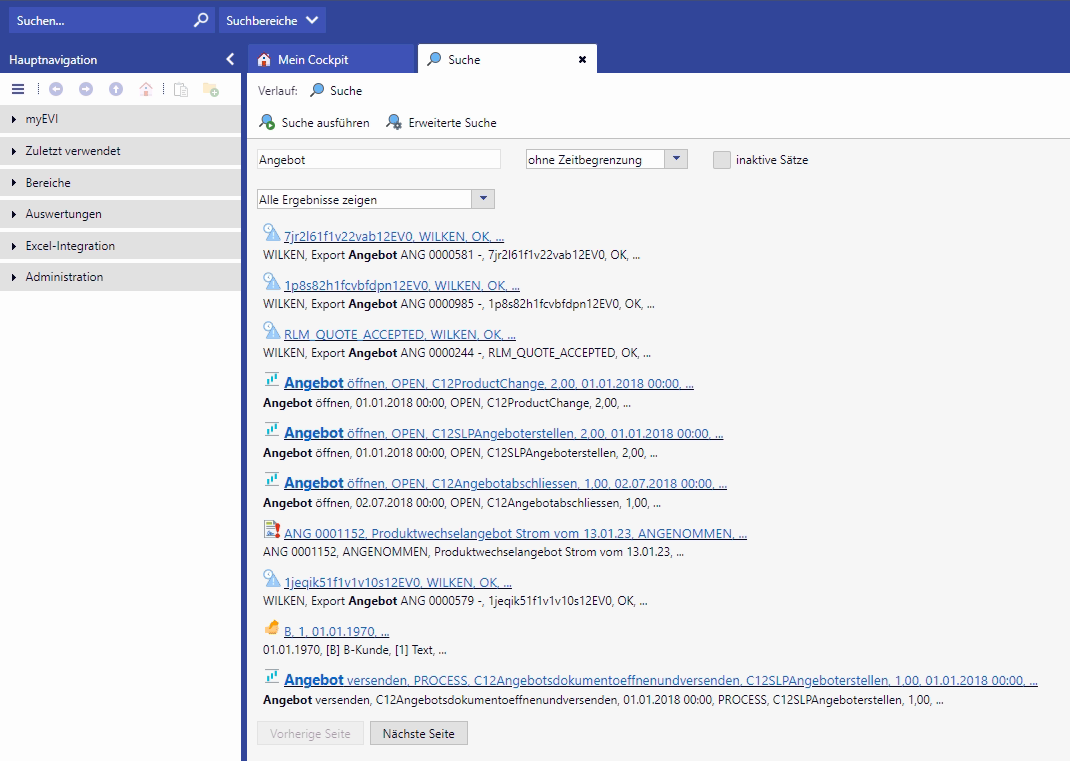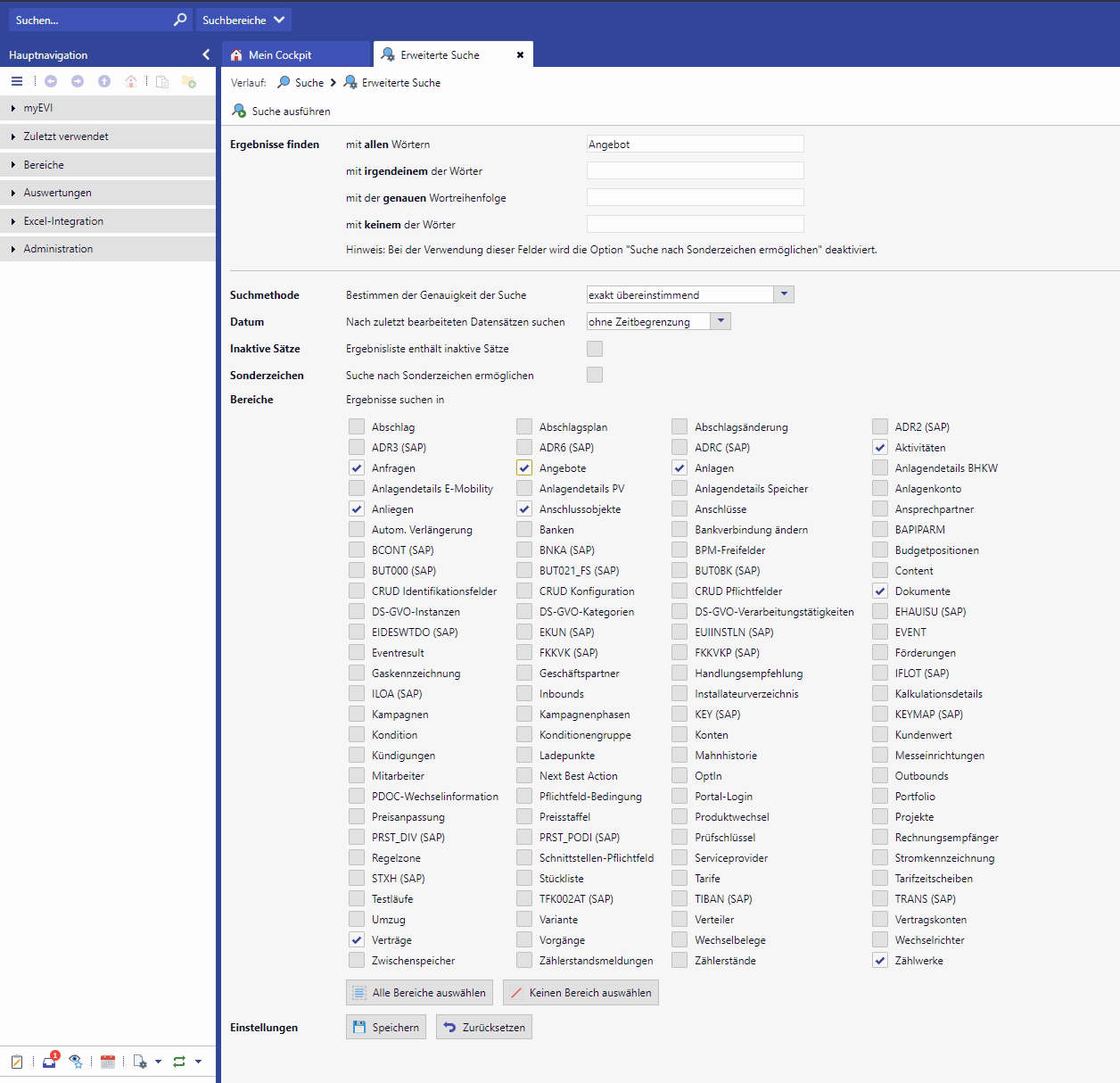COMMAND control system in Web Client
Basics
The COMMAND search is a full-text search, similar to well-known search engines on the Internet (e.g. Google, Yahoo). It searches for the entire database of CURSOR-CRM using one or more keywords. The search is used if you do not know the entity or essential information about the searched dataset.
The COMMAND field combines various functions:
the system search, a fuzzy search over the complete CRM-system (former functionality)
the execution of commands (hence "COMMAND").
the opening of cached CRM links
the execution of external calls

The input field 'COMMAND'

Configuration of the search area
If further hits are found, they can be displayed by clicking on the magnifying glass symbol or by pressing the enter key (see tooltip).
Doing a COMMAND search

To start the COMMAND search, enter the desired search term in the search field and click the magnifying glass symbol or the ENTER ↵ key. The search is preformed with the condition starts with.
Wildcards (* 'Star' or ? 'Question marks') are not supported.
The results are displayed in a separate tab. The found datasets are listed as links. The link invokes the dataset in CURSOR-CRM. Underneath the link are information from the dataset where the keyword of the search appears.
In case of only one search result, only the dataset and not the result page are opened.

Result list of a COMMAND search
The search results include all configured entities. You can open the hits sorted by entities in separate tabs.
To display the search results in a new tab:
Execute the search (click Execute search).
From the menu, select the search results for an entity that you want to display in the new tab.
Search results are displayed in the new tab.
Extended search
The Web Client also allows you to refine search criteria.
 Extended search | The search criteria can be extended using the Advanced Search link. |
Save | Click Save to save the configuration permanently. |
Reset | The last saved settings can be restored with Reset. |
Select all entities | All entities are activated for the advanced search. |
Select no entity | All entities are deactivated for the advanced search. |

Extended search
Instructions for the usage
Default configuration
Deactivation of documents and activities
Activated default entities: Contact persons, opportunities, quotes, business partners, projects, tickets.
For existing users, the check marks for documents and activities should be removed. If required, users can reactivate this, but this leads to poorer performance.
This only affects these two areas; if other areas have been configured, they remain unaffected; only documents and activities should be deactivated.
Intelligent search method
Intelligent search is the default setting of the search method

Selection of the search method
User settings overwrite system settings.
Arrangement and area selection
The area selection dialog is opened when you
tabbing from the search field to the area field and right-clicking the selection confirms the dialog opening
click on the area field
The dialog is closed when you
click on the active area field (hitting the Chevron arrow is not necessary)
click back into the search field
click into any other area of the CRM
Depending on which field you are currently in, it will be highlighted.
Sorting
To simplify the overview, the entities are divided into three groups:
Selected areas (Selected areas are all entities that will be searched)
Non-scanned areas (Non-scanned areas are all main entities (= available entities in the main navigation under "Areas") that are not selected and will not be searched)
Other non-scanned areas (Other non-scanned areas are all linked entities (= that cannot be accessed via the main navigation) that are not selected and will not be searched)
Sequence and characteristic:
Selected areas are pinned at the top of the list and are not expandable and collapsible
Non-scanned areas are displayed below in a collapsible
Default state when opening the area selection: expanded
Other non-scanned areas are again displayed under the 'Non-scanned areas'
Default state when opening the area selection: collapsed
can also be expanded by clicking on the Chevron or the line
Entities are sorted alphabetically, even within selected entities and unselected entities
If an entity is selected in the non-scanned areas, it will remain with a check mark in its original place, only the next time it is opened, the newly selected entity will be sorted and displayed under "Selected areas".
The same applies to "unchecking" selected areas
Save changes
Changes to the selection are saved persistently, even after ending a session the state is displayed.
Addition: In order to be able to continue searching non-persistently in the COMMAND field, power users can use the entity shortcuts, which can also be used in combination. If necessary, the entity shortcuts in the customer system can be extended for this case.
Filtering entities
When filtering in the area selection, the collapsible "Other non-scanned areas" is automatically expanded if it was not expanded before to make the search results found there visible.
Filter function is "case-insensitive"
Also, the matching characters will be highlighted in bold.
Tooltip area shortcuts
Because the area shortcuts are meaningless for beginners, a tooltip draws attention to their function.
The tooltip appears with a mouseover over the prefixes
Changes of the suggestion list
Suggestions for prefixes
In the search field, search suggestions or results are continuously updated as you type a search term. These also appear when a prefix is used.
Suggestions are also provided when an entity prefix is used.
Click in COMMAND
Click in COMMAND opens directly a suggestion list (without search input) with the last used datasets
Open the suggestion list only when clicking in COMMAND as well as when using the shortcut CTRL+ALT+F (i.e. when explicitly switching to the field)
Do not open the suggestion list when swiping, automatically changing focus in the cockpit or similar.
Empty State
In case of unsuccessful searches, an empty state is already displayed in the suggestion list
Resultless means when there are no results for both searches (interface elements and Lucene results)
Call the search result
In the case of the reference to further suggestions, the search result can be called up via a link.




